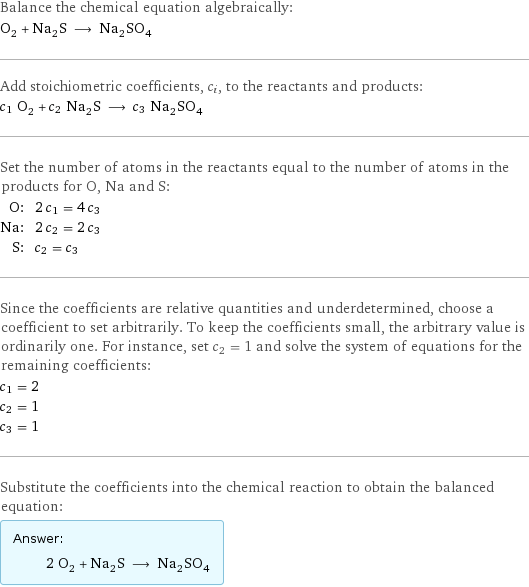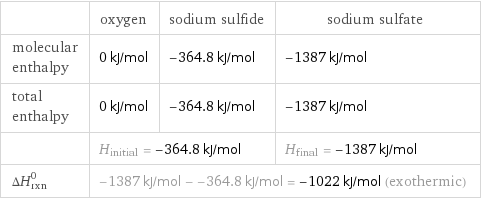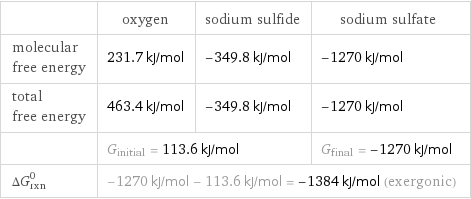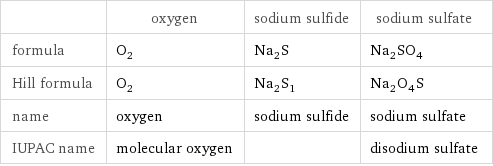Input interpretation

O_2 oxygen + Na_2S sodium sulfide ⟶ Na_2SO_4 sodium sulfate
Balanced equation

Balance the chemical equation algebraically: O_2 + Na_2S ⟶ Na_2SO_4 Add stoichiometric coefficients, c_i, to the reactants and products: c_1 O_2 + c_2 Na_2S ⟶ c_3 Na_2SO_4 Set the number of atoms in the reactants equal to the number of atoms in the products for O, Na and S: O: | 2 c_1 = 4 c_3 Na: | 2 c_2 = 2 c_3 S: | c_2 = c_3 Since the coefficients are relative quantities and underdetermined, choose a coefficient to set arbitrarily. To keep the coefficients small, the arbitrary value is ordinarily one. For instance, set c_2 = 1 and solve the system of equations for the remaining coefficients: c_1 = 2 c_2 = 1 c_3 = 1 Substitute the coefficients into the chemical reaction to obtain the balanced equation: Answer: | | 2 O_2 + Na_2S ⟶ Na_2SO_4
Structures

+ ⟶
Names

oxygen + sodium sulfide ⟶ sodium sulfate
Reaction thermodynamics
Enthalpy

| oxygen | sodium sulfide | sodium sulfate molecular enthalpy | 0 kJ/mol | -364.8 kJ/mol | -1387 kJ/mol total enthalpy | 0 kJ/mol | -364.8 kJ/mol | -1387 kJ/mol | H_initial = -364.8 kJ/mol | | H_final = -1387 kJ/mol ΔH_rxn^0 | -1387 kJ/mol - -364.8 kJ/mol = -1022 kJ/mol (exothermic) | |
Gibbs free energy

| oxygen | sodium sulfide | sodium sulfate molecular free energy | 231.7 kJ/mol | -349.8 kJ/mol | -1270 kJ/mol total free energy | 463.4 kJ/mol | -349.8 kJ/mol | -1270 kJ/mol | G_initial = 113.6 kJ/mol | | G_final = -1270 kJ/mol ΔG_rxn^0 | -1270 kJ/mol - 113.6 kJ/mol = -1384 kJ/mol (exergonic) | |
Equilibrium constant
![Construct the equilibrium constant, K, expression for: O_2 + Na_2S ⟶ Na_2SO_4 Plan: • Balance the chemical equation. • Determine the stoichiometric numbers. • Assemble the activity expression for each chemical species. • Use the activity expressions to build the equilibrium constant expression. Write the balanced chemical equation: 2 O_2 + Na_2S ⟶ Na_2SO_4 Assign stoichiometric numbers, ν_i, using the stoichiometric coefficients, c_i, from the balanced chemical equation in the following manner: ν_i = -c_i for reactants and ν_i = c_i for products: chemical species | c_i | ν_i O_2 | 2 | -2 Na_2S | 1 | -1 Na_2SO_4 | 1 | 1 Assemble the activity expressions accounting for the state of matter and ν_i: chemical species | c_i | ν_i | activity expression O_2 | 2 | -2 | ([O2])^(-2) Na_2S | 1 | -1 | ([Na2S])^(-1) Na_2SO_4 | 1 | 1 | [Na2SO4] The equilibrium constant symbol in the concentration basis is: K_c Mulitply the activity expressions to arrive at the K_c expression: Answer: | | K_c = ([O2])^(-2) ([Na2S])^(-1) [Na2SO4] = ([Na2SO4])/(([O2])^2 [Na2S])](../image_source/4f57621156d98a2407d1e2768beb9644.png)
Construct the equilibrium constant, K, expression for: O_2 + Na_2S ⟶ Na_2SO_4 Plan: • Balance the chemical equation. • Determine the stoichiometric numbers. • Assemble the activity expression for each chemical species. • Use the activity expressions to build the equilibrium constant expression. Write the balanced chemical equation: 2 O_2 + Na_2S ⟶ Na_2SO_4 Assign stoichiometric numbers, ν_i, using the stoichiometric coefficients, c_i, from the balanced chemical equation in the following manner: ν_i = -c_i for reactants and ν_i = c_i for products: chemical species | c_i | ν_i O_2 | 2 | -2 Na_2S | 1 | -1 Na_2SO_4 | 1 | 1 Assemble the activity expressions accounting for the state of matter and ν_i: chemical species | c_i | ν_i | activity expression O_2 | 2 | -2 | ([O2])^(-2) Na_2S | 1 | -1 | ([Na2S])^(-1) Na_2SO_4 | 1 | 1 | [Na2SO4] The equilibrium constant symbol in the concentration basis is: K_c Mulitply the activity expressions to arrive at the K_c expression: Answer: | | K_c = ([O2])^(-2) ([Na2S])^(-1) [Na2SO4] = ([Na2SO4])/(([O2])^2 [Na2S])
Rate of reaction
![Construct the rate of reaction expression for: O_2 + Na_2S ⟶ Na_2SO_4 Plan: • Balance the chemical equation. • Determine the stoichiometric numbers. • Assemble the rate term for each chemical species. • Write the rate of reaction expression. Write the balanced chemical equation: 2 O_2 + Na_2S ⟶ Na_2SO_4 Assign stoichiometric numbers, ν_i, using the stoichiometric coefficients, c_i, from the balanced chemical equation in the following manner: ν_i = -c_i for reactants and ν_i = c_i for products: chemical species | c_i | ν_i O_2 | 2 | -2 Na_2S | 1 | -1 Na_2SO_4 | 1 | 1 The rate term for each chemical species, B_i, is 1/ν_i(Δ[B_i])/(Δt) where [B_i] is the amount concentration and t is time: chemical species | c_i | ν_i | rate term O_2 | 2 | -2 | -1/2 (Δ[O2])/(Δt) Na_2S | 1 | -1 | -(Δ[Na2S])/(Δt) Na_2SO_4 | 1 | 1 | (Δ[Na2SO4])/(Δt) (for infinitesimal rate of change, replace Δ with d) Set the rate terms equal to each other to arrive at the rate expression: Answer: | | rate = -1/2 (Δ[O2])/(Δt) = -(Δ[Na2S])/(Δt) = (Δ[Na2SO4])/(Δt) (assuming constant volume and no accumulation of intermediates or side products)](../image_source/b202256cf79cf9e77ff0f0f222acf75c.png)
Construct the rate of reaction expression for: O_2 + Na_2S ⟶ Na_2SO_4 Plan: • Balance the chemical equation. • Determine the stoichiometric numbers. • Assemble the rate term for each chemical species. • Write the rate of reaction expression. Write the balanced chemical equation: 2 O_2 + Na_2S ⟶ Na_2SO_4 Assign stoichiometric numbers, ν_i, using the stoichiometric coefficients, c_i, from the balanced chemical equation in the following manner: ν_i = -c_i for reactants and ν_i = c_i for products: chemical species | c_i | ν_i O_2 | 2 | -2 Na_2S | 1 | -1 Na_2SO_4 | 1 | 1 The rate term for each chemical species, B_i, is 1/ν_i(Δ[B_i])/(Δt) where [B_i] is the amount concentration and t is time: chemical species | c_i | ν_i | rate term O_2 | 2 | -2 | -1/2 (Δ[O2])/(Δt) Na_2S | 1 | -1 | -(Δ[Na2S])/(Δt) Na_2SO_4 | 1 | 1 | (Δ[Na2SO4])/(Δt) (for infinitesimal rate of change, replace Δ with d) Set the rate terms equal to each other to arrive at the rate expression: Answer: | | rate = -1/2 (Δ[O2])/(Δt) = -(Δ[Na2S])/(Δt) = (Δ[Na2SO4])/(Δt) (assuming constant volume and no accumulation of intermediates or side products)
Chemical names and formulas

| oxygen | sodium sulfide | sodium sulfate formula | O_2 | Na_2S | Na_2SO_4 Hill formula | O_2 | Na_2S_1 | Na_2O_4S name | oxygen | sodium sulfide | sodium sulfate IUPAC name | molecular oxygen | | disodium sulfate
Substance properties

| oxygen | sodium sulfide | sodium sulfate molar mass | 31.998 g/mol | 78.04 g/mol | 142.04 g/mol phase | gas (at STP) | solid (at STP) | solid (at STP) melting point | -218 °C | 1172 °C | 884 °C boiling point | -183 °C | | 1429 °C density | 0.001429 g/cm^3 (at 0 °C) | 1.856 g/cm^3 | 2.68 g/cm^3 solubility in water | | | soluble surface tension | 0.01347 N/m | | dynamic viscosity | 2.055×10^-5 Pa s (at 25 °C) | | odor | odorless | |
Units
